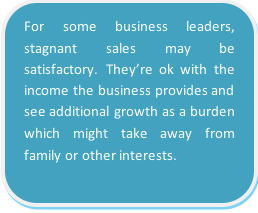
Suppose you’ve been in business for a while but your revenues are not increasing. Or worse, your revenues are declining. In my last post, I discussed metrics for measuring the success of your process, assuming you were energized and creative enough to work towards a successful process.
In this post, I want to address a different type of situation; slow growth, stagnation, decline, inconsistency in your revenue streams. How should you examine your process?
Fix the Root Cause
If your business is mature and your revenues are stagnant or declining, what is the root cause if you see customer acquisition as a process?
My favorite way to get to root cause issues comes from Lean Thinking. In Lean Thinking, the approach is to ask the “Five Why’s” Below is an example of the five-why approach.
 Shawn above is an example of a Five-Why approach to discover root cause issues. Typically, after the 5th “Why”, you can be very close to identifying a root cause.
Shawn above is an example of a Five-Why approach to discover root cause issues. Typically, after the 5th “Why”, you can be very close to identifying a root cause.
Are there typical root causes?
If your revenue growth is stagnant, I would encourage you to question yourself and others in the business until you find your root cause(s).It is better to act than to accept your current state of affairs.
Are there patterns which repeat?
Here are some possibilities; I’ve witnessed all of these:
- Your customer acquisition process is valid, but you haven’t made the decision to spend more on customer acquisition. Have you budgeted enough? Is there an issue regarding resources, like hiring salespeople or spending on social media, for example.
- A corollary: maybe you aren’t confident your acquisition process is valid. Do you need to be prodded to act? When something is going wrong, it can be stressful. Some people react by doing nothing, unwilling to face the issue.
- Your acquisition process was previously valid, but something has changed. Is there a competitor doing something which changes the dynamics with your target customer segment?
- Organizational misalignment. If there are people in high places in your organization who are not buying in to the direction of the company, you may be sending mixed messages to your target companies. I can assure you target customers who are considering doing business with you are doing diligence. You do not want them to get the impression your company internally disagrees on strategy and tactics.
- Inarticulate Communication. Maybe there are good reasons target customers should do business with you, but the way you say it, the frequency with which you say it, and the emphasis you put on key points does not do justice to benefits of doing business with you.
A case study
I recently had the opportunity to review three years’ financials for a business which was being marketed for sale.
On the surface, the profitability of the business was steady. However, if you studied the details of the financial statements, you could see that the profits three years ago were generated by a business which was growing about 25% over the previous year. The payroll was larger and there were adequate and reasonable amounts spent on marketing.
In the following year, payroll was cut and marketing expenses reduced. The company made the same profits but there was no growth.
In the third year, payroll was further cut, and marketing essentially reduced to zero. Profits were still the same, but in my opinion, the business now looked more like a turnaround situation, even though the profits were still the same. I could not value the business in the third year as I would have in the first year.
 About the Author: Bob Kroon is a coach for high-performing Founders, CEO’s, and Owners. He founded Expeerious, LLC (expeerious.com) in 2015 to exclusively focus on coaching the success of Top Executives. For over 25 years, Bob served variously as CEO, COO, Division President, and Group Vice President.
About the Author: Bob Kroon is a coach for high-performing Founders, CEO’s, and Owners. He founded Expeerious, LLC (expeerious.com) in 2015 to exclusively focus on coaching the success of Top Executives. For over 25 years, Bob served variously as CEO, COO, Division President, and Group Vice President.
The majority of his career was in manufacturing durable goods. Bob is an enthusiast and practitioner of Lean Thinking since 1986. He also has broad skills in M&A including financial modeling, deal structure, diligence, and post-close integration.
Bob’s current clients are diverse and include businesses in healthcare, agricultural products, robotics, luxury goods, and education.
To learn more about how Bob coaches and thinks, you can find over 200 questions he’s answered on Quora. Visit his website at: www.expeerious.com for additional blog posts.

